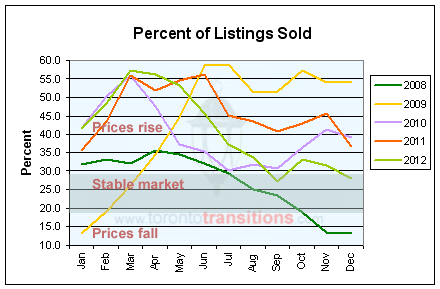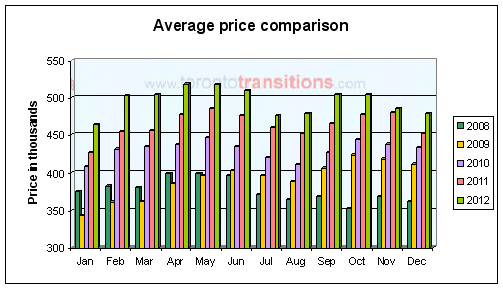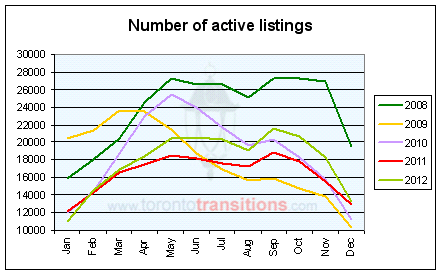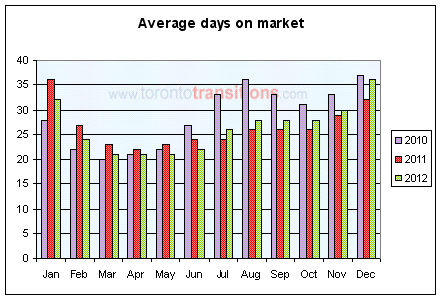Statistics on sales of freehold houses in the City of Toronto:
Graphs illustrating the performance of Toronto real estate market since 2008:
The opinions on the state of real estate in Toronto can be divided into two camps. One camp insists that Toronto home sales and prices became unsustainable, and the real estate market is heading for a crash. Another group of experts argues that the leveling of the home and condo prices, combined with mortgage rates which remain historically low, will tempt buyers who postponed their purchase to return to the market.
Second half of 2012 saw a decline in the number of sales, but, at the same time, the number of active listings which was rising between January and May became flat until July and then dropped in August. After a 13.5% increase in September the number of active listings has been dropping, and reached in December the level only 2.9% higher than in December 2011.
Average real estate price in Toronto in December was 6.5% higher on a year-over-year basis. That followed a rather insignificant increase on November, but the average for the whole year was up 6.8%.
The most telling statistic is the ratio of sales to active listings at any given point. That ratio is illustrated in our first graph, "Percent of Listings Sold". For the first time since April 2009 that ratio moved into a stable market area last year, first in September, only to return to the sellers' market territory in October and November, and then back to the stable market in December.
Sales in the City of Toronto were hurt more than in the outlying area, due to two factors: the Toronto Land Transfer Tax, which reduces the amount of down payment on every transaction in the City of Toronto, and the restriction on government insured mortgages, which not are available only up to sale prices of 1 million dollars. Toronto has substantially more homes which now don't qualify for high ratio financing.
The factors listed below influence real estate sales and property prices:
-
At present we are expecting interest rates to remain low through 2013. Although the lending guidelines have been tightened, borrowing for home purchase still remains affordable.
-
Real estate market is driven by supply and demand. Unless supply increases, the pressure on prices continues. In November we saw 1.3% more new listings than in 2011. But new listings decreased from October levels by 24.6%. In December available listings declined from November levels by 27.7%, while 56.3 fewer properties were listed.
-
Employment levels are gradually improving, and immigration levels remain steady.
We encourage you to view
video presentations by Jason Mercer
, TREB senior manager of market analysis.

The following graphs illustrate the performance of Toronto real estate market since 2008:

The graph above illustrate the main attribute of a real estate market - the percentage of available listings sold each month. A typical stable market, with buyers able to negotiate purchase prices, but, at the same time sellers able to sell their homes or condos, is when the proportion of sold to available listings is between 18% and 28%.
When fewer than 18% of available homes sell, prices fall, and the situation is referred to as a "buyers' market". When more than 28% sell, prices rise, and we have a "seller's market". As you may notice on this graph, in the last five years we have only once experiences a "buyer's market", in the last quarter of 2008. In the summer months of 2010 the market bordered on "stable", and in September this year it briefly entered the 'stable market' conditions, returning to the "seller's market" in October and November and dropped back to the "stable market" levels in December.

As you can see on the graph above, Toronto real estate prices have risen, but they still follow the typical yearly trend, although in October they remained flat. Average prices depend on the general real estate price trend, but also what type of properties are selling at any given time.
2008 and 2011 were unusual years, with average prices in November higher than October average. This year the average prices dropped from October to November, only to level off towards December. 2012 ended with the average prices 6.8% higher than last year.

The number of active listings has been increasing between March and May, and remained at the same level in June and July, to drop in August, and rise again in September. But in October 14% fewer properties were listed for sale, and the number of available listings dropped by 4%. That decline continued for the remainder of 2012.
On a year-over-year basis the number of active listings was higher in November by 17.8%, but the supply was going down following a similar curve to the last year's inventory, to end only 2.9% higher in December.

Since the beginning of 2011, real estate listings in Toronto were selling, on average, within one month. If a property takes longer than the average to sell, the reason is either too high a listing price, poor condition of the house, or inadequete access for showing it. In December a bit longer time was necessary, but not by any large amount, as you can see on the graph.
Following tables illustrate sales of freehold homes (not including condo apartments and condo townhouses) in Toronto since the beginning of 2012:
In January:
|
Area
|
number of sales
|
100% of list
|
>100% of list
|
% of homes sold over asking
|
|
Central
|
279
|
28
|
110
|
39.4%
|
|
East
|
332
|
28
|
120
|
36.1%
|
|
West
|
266
|
15
|
58
|
21.8%
|
In February:
|
Area
|
number of sales
|
100% of list
|
>100% of list
|
% of homes sold over asking
|
|
Central
|
468
|
47
|
231
|
49.4%
|
|
East
|
532
|
65
|
244
|
45.9%
|
|
West
|
436
|
50
|
150
|
34.4%
|
In March:
|
Area
|
number of sales
|
100% of list
|
>100% of list
|
% of homes sold over asking
|
|
Central
|
636
|
59
|
320
|
50.3%
|
|
East
|
699
|
79
|
329
|
47.1%
|
|
West
|
589
|
63
|
240
|
40.7%
|
In April:
|
Area
|
number of sales
|
100% of list
|
>100% of list
|
% of homes sold over asking
|
|
Central
|
681
|
65
|
357
|
52.4%
|
|
East
|
805
|
95
|
384
|
47.7%
|
|
West
|
668
|
80
|
256
|
38.3%
|
In May:
|
Area
|
number of sales
|
100% of list
|
>100% of list
|
% of homes sold over asking
|
|
Central
|
735
|
86
|
301
|
40.9%
|
|
East
|
817
|
110
|
359
|
43.9%
|
|
West
|
710
|
71
|
259
|
36.5%
|
In June:
|
Area
|
number of sales
|
100% of list
|
>100% of list
|
% of homes sold over asking
|
|
Central
|
539
|
62
|
176
|
32.6%
|
|
East
|
723
|
93
|
265
|
45.9%
|
|
West
|
603
|
70
|
192
|
31.8%
|
In July:
|
Area
|
number of sales
|
100% of list
|
>100% of list
|
% of homes sold over asking
|
|
Central
|
338
|
28
|
66
|
19.5%
|
|
East
|
531
|
63
|
142
|
26.7%
|
|
West
|
405
|
51
|
85
|
21.0%
|
In August:
|
Area
|
number of sales
|
100% of list
|
>100% of list
|
% of homes sold over asking
|
|
Central
|
258
|
27
|
45
|
17.4%
|
|
East
|
431
|
49
|
95
|
22.0%
|
|
West
|
310
|
27
|
55
|
17.7%
|
In September:
|
Area
|
number of sales
|
100% of list
|
>100% of list
|
% of homes sold over asking
|
|
Central
|
381
|
42
|
103
|
27.0%
|
|
East
|
503
|
67
|
124
|
24.6%
|
|
West
|
379
|
39
|
89
|
23.5%
|
In October:
|
Area
|
number of sales
|
100% of list
|
>100% of list
|
% of homes sold over asking
|
|
Central
|
430
|
48
|
112
|
26.0%
|
|
East
|
537
|
53
|
122
|
22.7%
|
|
West
|
453
|
42
|
105
|
23.2%
|
In November:
|
Area
|
number of sales
|
100% of list
|
>100% of list
|
% of homes sold over asking
|
|
Central
|
342
|
35
|
54
|
15.8%
|
|
East
|
444
|
42
|
73
|
16.4%
|
|
West
|
374
|
37
|
70
|
18.7%
|
In December:
|
Area
|
number of sales
|
100% of list
|
>100% of list
|
% of homes sold over asking
|
|
Central
|
185
|
10
|
25
|
13.5%
|
|
East
|
279
|
26
|
31
|
11.1%
|
|
West
|
214
|
15
|
29
|
13.6%
|
If you are interested in statistics from a particular neighbourhood or street, please call or e-mail us, and we will be happy to prepare the information for you.
For information on real estate conditions in Toronto in 2010, please visit our
2010 report
. Please visit our
2011 Market Conditions
page for comparison.


